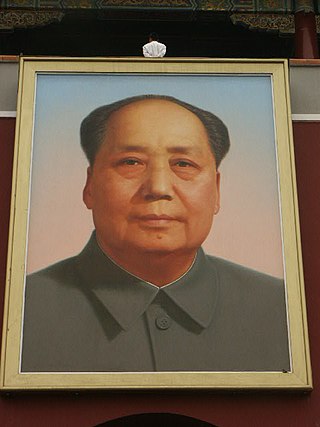Top Qs
Timeline
Chat
Perspective
Portraits overlooking Tiananmen
Successive portraits overlooking Tiananmen Square From Wikipedia, the free encyclopedia
Remove ads
A hand-painted, framed, oil portrait of Chairman Mao Zedong overlooks Tiananmen Square in Beijing, China. Measuring 6 × 4.5 metres and weighing up to 1.5 metric tons, it is the largest hand-painted portrait in Asia. Made partly of fiberglass and reinforced plastic, the portrait is replaced every year ahead of China's National Day on October 1.[1]

Remove ads
History
Summarize
Perspective
Background
Tiananmen Gate (Chinese: 天安门, "Gate of Heavenly Peace") was constructed in 1420 by the Ming dynasty as the main entrance to the Imperial City, within which the Forbidden City was located. Over the centuries, the monumental structure, positioned just north of what is now Tiananmen Square, grew in national significance. By the 20th century, Tiananmen had become a powerful symbol of China itself.[2] Its importance made Tiananmen Gate a natural location for the display of portraits of national leaders, whose images projected their legitimacy and influence over the nation.
Before the People's Republic
The first portrait to be displayed at Tiananmen Gate, which started the "tradition", was a portrait of Chinese revolutionary and statesman Sun Yat-sen. His portrait was hung up in 1925 by the government of the Republic of China, after his death in March of that year. In 1945, after the Chinese victory over the Empire of Japan, the Nationalist government of China replaced the portrait of Sun Yat-sen with a portrait of the leader of the Republic, Chiang Kai-shek. Continuing to commemorate the Second Sino-Japanese War, in July 1949, after the Pingjin Campaign, which saw the peaceful seizure of Beijing (and Tianjin) by the People's Liberation Army, portraits of Mao Zedong, Zhu De, and other Chinese communist revolutionaries were hung up at Tiananmen Gate.[3][4]
In the People's Republic
The first singular portrait of Mao Zedong at Tiananmen Gate was created for the proclamation of the People's Republic of China on October 1, 1949, replacing the multiple portraits that had been displayed previously. Ever since, only a single portrait has been displayed at Tiananmen. On March 9, 1953, Mao's portrait was temporarily replaced by one of Joseph Stalin to commemorate Stalin's death four days earlier.[4] After Mao's own death in September 1976, his color portrait was replaced by a black-and-white photograph taken by the Xinhua News Agency, accompanied by black banners announcing his state funeral.[1]
Over the decades, the portrait has been the target of several acts of vandalism. During the Tiananmen Square protests in 1989, a group of protesters, including Yu Dongyue, vandalized it by throwing eggs. Yu was sentenced to life imprisonment but was released on bail 17 years later, in 2006.[5] In May 2007, the portrait caught fire, damaging about 15 percent of it; a 35-year-old unemployed man from Ürümqi, Xinjiang, was arrested for the incident, and the portrait was subsequently repaired.[6] In April 2010, another protester attempted to deface the portrait by throwing a plastic bottle filled with ink, though he missed, and the bottle instead struck the wall near the portrait. He was arrested shortly afterward by Beijing police.[7]
Remove ads
Artists
Summarize
Perspective
Artist Zhou Lingzhao was commissioned to paint the portrait of Mao Zedong at Tiananmen Gate for the proclamation of the People's Republic of China on October 1, 1949. This portrait of Mao was replaced in May 1950 by one painted by Xi Mang. From 1950 to 1964, the portrait of Mao was produced by a team of artists led by Chinese portrait painter Zhang Zhenshi.[8][9][10] In 1964, Wang Guodong replaced Zhang as the lead artist. Unlike previous efforts, Wang was the first to paint the portrait by himself. However, during the Cultural Revolution, he was harassed and subjected to a public struggle session, later forced to work for two years as a carpenter at a framing factory. Despite this, he resumed his painting duties and continued creating the portrait through the Cultural Revolution until 1976.[11] Following Mao's death that year, Wang retired. In early 1977, Ge Xiaoguang, a student of Wang Guodong, took over the responsibility. Since then, Ge has continued the tradition of repainting and re-hanging Mao's portrait each year, working from a studio located near Tiananmen Square.[1][12]
Lead painters of Mao's portraits
- Zhou Lingzhao 1949–1950
- Xi Mang 1950
- Zhang Zhenshi 1950–1964
- Wang Guodong 1964–1976
- Ge Xiaoguang since 1977
Remove ads
Portraits overlooking Tiananmen over time
 |
 |
 |
 |
 |
 |
See also
References
Wikiwand - on
Seamless Wikipedia browsing. On steroids.
Remove ads
